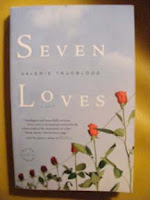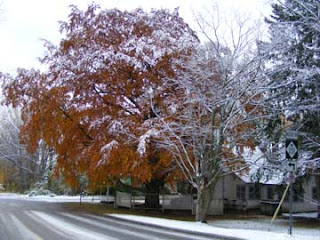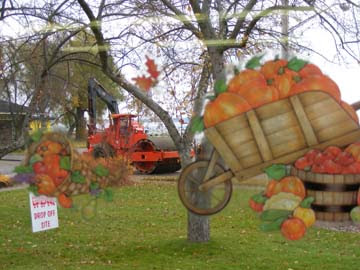
A line in the space of time: on one side, 2007, and on the post-midnight side, 2008. The line feels so arbitrary. Organic seasons meld into one another gradually, but the celestial mark provided by the solstice would make sense. Oh, well. As it is, so be it. Here, on the fast-disappearing ground this side of the line, are a few of my thoughts as the year comes to a close.
A FARAWAY FRIEND:
This morning’s e-mail brought a message from a bookseller colleague that began, “It makes me smile, too, to know that you and I are still around and that there are people who love our shops.” I smiled reading that. My friend ended with “I'm so happy that we have arrived at much the same destination through our very different paths.” Me, too!
Although the actual time we have spent in one another’s company through the years can be measured in a few brief hours, this friend’s importance in my life is out of all proportion to time. We share our love of books and the joys of bookselling, as well as its frustrations, struggles, fears and heartaches. We take comfort in one another’s persistence, knowing that neither of us is alone as long as the other still has her bookstore, too. When someone tells me they love her shop or tells her they love mine, we rush to share the compliment. Another year, Mary! We’ve made it through another year!
SHORT STORIES:
Why are volumes of short stories such a hard sell these days, and what happened to diminish the popularity of the form? Where do we look for the explanation?
Magazines? It doesn’t take much of a search to realize that there are fewer popular magazine outlets for short fiction than existed 50 years ago. But if there’s a causal connection here, which way does the arrow point? Are short stories less popular because fewer are published, or did falling popularity erode their platform?
Book publishers? One writer I know blames book publishers for failing to market short stories aggressively. “Novelists are treated like rock stars,” this informant says, implying the undeniable difference. Well, some novels are treated like rock stars, but most are not, I’d say. Anyway, if short stories were hot, wouldn’t publishers be the first to jump on that bandwagon? Here, too, I have to question the direction of the causal arrow. (Or maybe it goes in both directions?)
How about “investment mentality”? You would think that heightened demands on personal time, overbooked schedules, long commutes, etc., would send people running away from long novels and straight into the welcoming arms of short stories, but such is not the case, and the only way I can make sense of it, after listening to what readers say, is in terms of a widespread investment mentality, a deeply held but unarticulated desire for a big payoff to time spent reading. Picture a reader finishing the first short story in a book with the belief that it was the first chapter in a novel. The reader turns expectantly and eagerly to the second story and finds—END OF GAME! Deposit more coins to play again! Yes, Virginia, now you have to invest your energy in getting to know all new characters! Even in collections that feature reappearing characters, I’ve also heard complaints about the lack of an “ending” to a short story collection.
It’s a shame, really. Not only is the short story a convenient and portable form, fitting comfortably into busy lives, but the best short stories, like the best poetry, are distillations of worlds--of character development, of plot, of language itself. “Each one is a jewel!” a friend exclaimed about one collection she had discovered. Looked at this way, the payoff is huge for the time invested! What’s required to see it this way, though, is a different set of expectations.
I was reminded to write about this topic (how can I have neglected it for so long?) by discovering a book blog issuing a short story challenge for 2008. If you’ve neglected short stories, consider accepting Kate’s challenge. You’ll have plenty of time left for reading history, memoirs, novels and all those fun books on economics, politics and the environment that come at us faster than we can possibly get through them.
CREATIVE OUTLET?
Writing is something I think about more often than I do it, except for this site. Getting any further along in my 'tween novel this winter (it was begun last March and set aside all summer and fall) looks doubtful, what with commuting to Traverse City to teach philosophy two mornings a week (unexpected addition to winter workload), on top of running the bookstore. Preparing classes, teaching, grading—all that takes up a lot of mental space. It's also been two years since my last winter trip to Florida, when pencil drawing was the pleasant vacation assignment I gave myself, and that’s something else I don’t expect to do this winter. But there is still the blog, and I try to be faithful to it.
David asked if I “have to” write something every day. There is no obligation, I told him, but if my regular readers logged on and found nothing new for several days in a row, I could easily lose them. There’s a certain satisfaction in having someone tell me they read me every day. Some like the pictures best, and that’s all right, too, but even that takes some preparation and attention. (I’ve held back from promising a new picture every day, but those who visit frequently know that I try!)
So, is this self-imposed obligation worth the effort that goes into it? There have been a few new recent customers to the Dog Ears Books website who found it through the blog, but the blog itself is much more than a sales device. I write it as much for myself as for an audience (though connecting with you readers is part of what’s important to me). So as long as I enjoy the writing and can find the time, it's worth it.
Keep reading, my friends! (Blogs AND BOOKS!) And have a happy, healthy, meaningful, productive, peaceful, hard-working new year!!! As my friend Ellen likes to say at the close of her e-mails, “Onward and upward!”

































